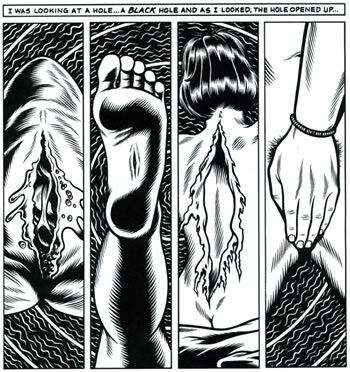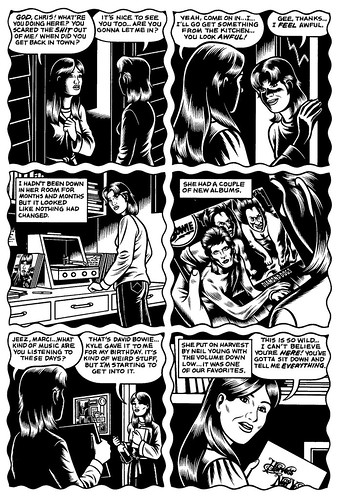'...and now you're one of us'
Black Hole
by Charles Burns
Before the arrival of his latest work (X'ed Out - a review here soon) and the adaptation of this graphic novel into a film (with David Fincher's name currently attached) I thought it was high time that I read Charles Burns' iconic Black Hole. Burns' distinctive artwork has looked down at me from bookshelves for years and adorns the front of The Believer magazine, its clean lines and block colouring (if that's an appropriate term for the black and white illustrations of Black Hole) instantly pleasing to look at. With this book the emphasis is very much on the 'black' of black and white with each page's details highlighted in sharp contrast to the blackness they emerge from. That's just right for this dark and disturbing work that taps into the fears and passions of our teenage years and deals with issues like change, disease, peer pressure and alienation.
Set in the midst of 1970's suburban Seattle 'back when it wasn't exactly cool to be hippie anymore, but Bowie was still just a little too weird' we meet a variety of high school teenagers. The opening few sections (the work was originally serialised) are hypnotic and confusing but slowly we learn that some form of disease is plaguing the young, transmitted sexually, manifesting itself differently with each person. Some kind of physical change is inevitable, but whilst for some it is obvious and disfiguring for others the changes are subtler and can be hidden, for a while at least. On a very simple level this chimes with the very real threats of sexually transmitted infections amongst teenagers, something of a news item recently with numbers on the rise, and something with which teenagers are prepared to gamble in the face of raging hormones and a desire to lose one's virginity.
We watch as Keith lucks out in Biology class and is sat next to 'total fox' Chris only to suffer some kind of dream-like visions (above) before fainting. Later we see Chris behaving uncharacteristically at a party, leaving with Rob and taking him to the cemetery where he tries to let her know something before they have sex, only for her to quiet him and go ahead. Keith will eventually have his own confusing sexual encounter with Eliza, dubbed the Lizard Queen by her housemates, and each of these events will change their lives forever. Your teenage years are all about transformation, puberty does some cruel things with people sprouting height, breasts, hair all over the place and spots and pimples too. Developing these physical transformations into something slightly more alien and grotesque is a brilliantly unsettling thing to watch. However freakish they are, we as a reader 'know' something of that feeling and can't help but empathise. The real strength of the book is that it doesn't descend into a freak show or become a battle against the disease but instead taps into the neuroses of high-school, the us and them of peer groups and their power structure and also the changing fashions of the time.
I couldn't help but think of David Cronenberg with the physical aspects of this book but Fincher sounds like a great directorial choice to recreate the period after the specificity of his work on Zodiac. The project has been talked about for a while and is no nearer actual filming but if it does happen then viewers will need a strong constitution. Burns' artwork is genuinely horrifying in places and he creates a dizzying effect at just the right moments by drawing longer panels and placing both narration and speech on the same page, sometimes separated by the length of the whole page so that our eyes have to flick up and down as we read along. Sinister dolls in the woods, tortured artwork by characters, nightmares and the inevitable arrival of violence all add to the oppressive atmosphere. If you thought your teenage years were hell then there might be something worryingly familiar between the inky pages of Burns' vision.









0 comments:
Post a Comment